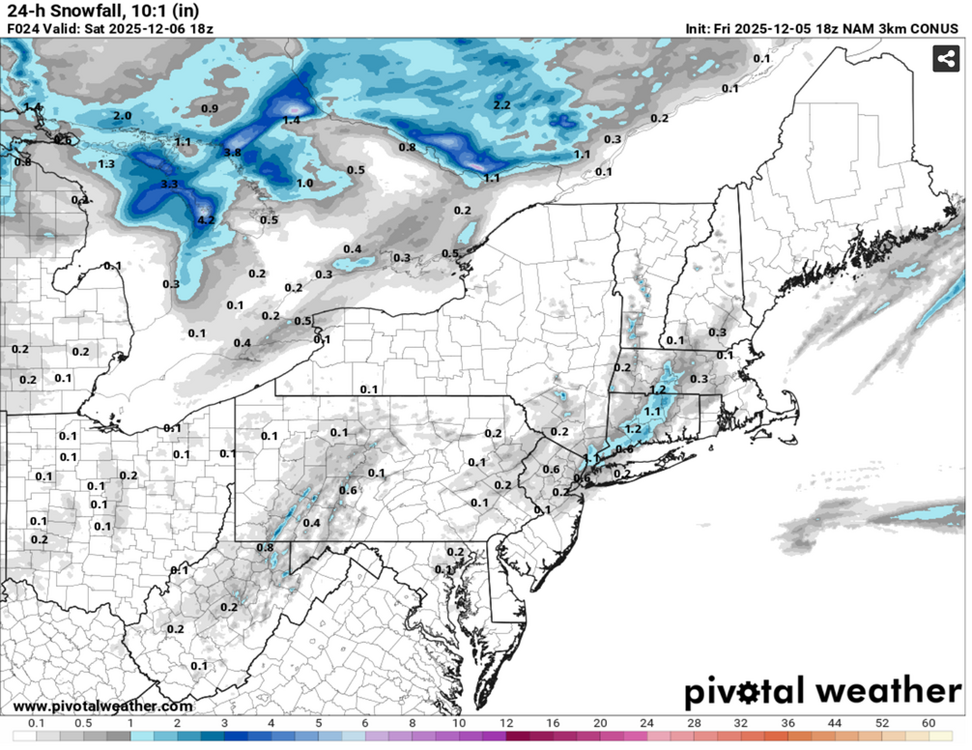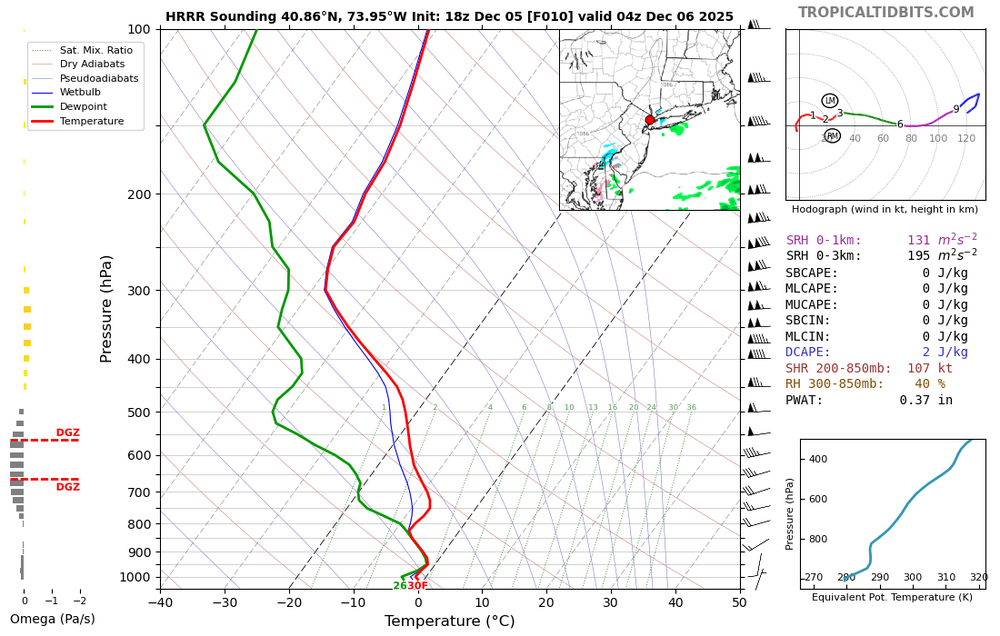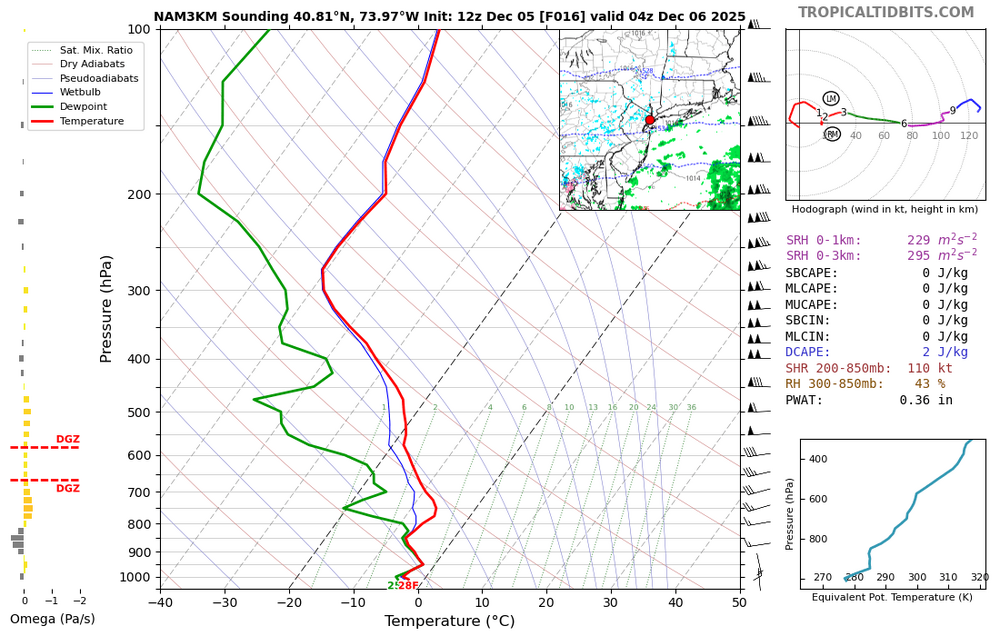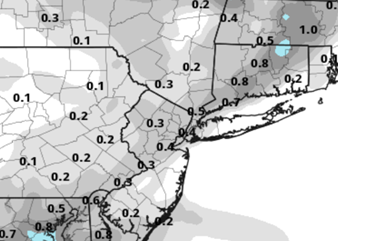
eduggs
Members-
Posts
5,480 -
Joined
-
Last visited
Content Type
Profiles
Blogs
Forums
American Weather
Media Demo
Store
Gallery
Everything posted by eduggs
-
I get the pessimistic sentiment. I feel it too. But the reality is we just don't know how things will play out. Some of our best snowstorms seemingly came out of nowhere. And the positive surprises are more fun than fretting for a week about a modeled blizzard that might disappear.
-
Sunday isn't lost yet. The next day or so will likely resolve whether or not this is a potential wintry threat. The ICON, ECM-AI, GFS-AI, and GEFS support a possible snowstorm. The other guidance (UK, ECM, CMC, GEPS, EPS) aren't too far off.
-
Yeah good to see the GEFS mean with a slight improvement over 12z and better than the op. Every step in the right direction is welcomed. This next 24 hours of modeling will likely reveal if this will be a wintry threat or not.
-
Far NW suburbs still on track for a possible C-2" tomorrow. Unlike last week which was more of a latitudinal gradient, this potential wintry event has a stronger elevational component. I could see the top of Schunnemunk or Mt. Beacon getting an inch or two of snow while the Hudson River towns get zilch. Elevated NW NJ could get a little accumulation this time too.
-
The 12z NAM family has an advisory snowfall for NW burbs (Sussex, N. Morris, Orange, Putnam) probably above 300ft or so. But there's no support from the other meso models. The NAM also keeps it going for longer. Other models are warmer and shorter duration. I'd sell the snowier outcome for now but keep an eye on the mesos tonight. The airmass is cold but the southerly flow will warm things quickly tomorrow. The multi-day trend of a higher amplitude trof has delayed the onset and pushed the initial overrunning well north of us. That hurts wintry chances outside of hill towns.
-
There's pretty good support for some wintry precipitation for the I-84 corridor early Wed. This has been trending colder for several days. Some guidance gets it as close as Morris, Rockland, Westchester counties. A cold Tue night will give some a chance, but the boundary layer will warm quickly early Wed. Does the initial precip. pass well to the north and then basically a cold front passage, or does it shift far enough south for a few hour burst of snow/IP/ZR... something to watch...
-
You seem to have a very narrow and rigid way of looking at weather and statistics. That's fine. Considering the relatively small sample size of seasons and the highly variable nature of local weather, I prefer to use a less rigid framework when assessing future possibilities... just a difference of preference and interpretation.
-
12z NAM (12km) is a little less snowy then 6z. But the 3km is still pretty cold. It has brief snow to ZR and back to snow. I'm not sure I buy that scenario. This looks more like frozen to rain to cold/dry with flurries to me. Either way... interesting solution. As modeled, the 3km NAM is cold enough for travel impacts N&W of NYC. I'm skeptical since surface temps tend to overperform warm with a SLP to our northwest. But other guidance is pretty cold too... so we'll see.
-
We don't need a benchmark track or a major snowstorm. There are a hundred ways to get snow in our area. We just need a little luck with shortwave evolution. Sometimes "suppression" favors coastal Georgia, and other times it favors our area. It depends on minor details in the upper level and its progression. I believe it is wrong to lump everything into a box to try to explain it considering the forces that drive weather are extremely complex and variable. Every day, every weather map, every situation is unique. This year Chicago, Albany, NY, Richmond, and Mt. Mansfield are way ahead of ave. snowfall to date. That random list of cities could easily have included NYC with minor changes to how events played out.
-
NAM, HRRR (end of run), GFS, ECM are all pretty cold (and a little snowy) for Wed morning NWNJ and I-84 area. The Canadian and RRFS are a little warmer and pivot the steadier precipitation a little north of the area until the boundary layer warms. I'd like to see this evolve into a 1-2" deal for Sussex, Orange, Putnam with flakes (coating?) or sleet into northern Morris, Passaic, Rockland, Westchester.
-
And the southern Piedmont of Virginia
-
Most models have a little bit of snow on Wednesday for approx. I-84 north, favoring elevation and especially latitude. This has been trending slightly colder for several days. I think it will be tough to accumulate much with a surface low near Lake Ontario... but considering Tue night is likely to be fairly cold, if precipitation comes in a quick burst I think there could be some minor accumulations before the boundary layer quickly warms. A slight model shift colder would help, but guidance has been very consistent curling up this shortwave west of us.
-
Anybody notice how far south the Wed shortwave has gotten on the GFS? It gets the 500mb 540dm contour all the way down into the Carolinas this run (0z). It's been steadily shifting south for maybe a half dozens runs now. It probably doesn't mean much given the relative short range (and lack of support)... but any further south and northern parts of the region would be in the game for some wintry precip. The Poconos are already in the game. I-84 region is borderline.
-
It's pretty cool to see embedded bursts of steadier snow with real snowflakes and maybe 1mi visibility. These bursts are evident on radar as parallel bands oriented transverse to the direction of movement. Model soundings were reflective of the low level pixie dust stuff that's forming below the radar beam. But the heavier banded stuff is actually showing up on radar and accumulating.
-
Pretty snowy night out there. Alternating flurries and light snow with intensity gradually increasing since 9pm or so. Probably a few tenths accumulation on all surfaces... could be some slick spots. Nice job by the hi-res models even days in advance. I'm not sure how well models would have picked this up 15 years ago.
-
Saturation is below the snow growth zone. The moisture is very shallow. That's probably snow grains and/or ZR. Not impossible a few spots get lucky if lift/saturation is more robust than modeled... seems doubtful for now.
-
The low level moisture moving in on a SSE flow is already visible on radar off the NJ coast. If it's ZR, I can see short-fused advisories being posted. I hope it's snow/snow grains instead.
-
The 18z 3km NAM has 0.1" liquid for part of the region tonight. I'm skeptical that it can accumulate much due to snow growth problem. But sometimes these low level lift/crystallization events that linger for several hours over an area can surprise. I'll take the under for now.
-
-
Examining model soundings for tonight, it looks like saturation is mostly below the snow growth zone. That suggests maybe freezing drizzle and snow grains.
-
Cycling through all model guidance from 0z to 12z it's kind of funny to see what looks like a snow force field in effect for our area. Plenty of action but it's either north or south. Hope it changes soon.
-
The GFS is an outlier with respect to Sun-Mon. There is very little overlap between the EPS/GEPS and the GEFS right now. But... the GFS has trended "better" for a few runs now. Negatives are north SLP track and southerly winds, positives are decent antecedent airmass and potent shortwave.
-
The RGEM snow accumulation map I showed in now through Saturday. I should have showed the time stamp and duration. There's a weak mid-level shortwave interacting with the offshore SLP. It could generate snow showers on Saturday. I agree that the Friday and Sunday events are frustration.
-
The RGEM has a little snow early Saturday. It's not much and it will probably shift east or be flurries if it's even real, but it's something...









